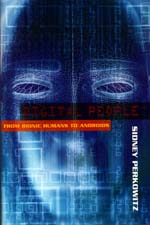“A comprehensive yet compact survey of robots and bionics. Rather than intoning the usual litany of robots, Perkowitz sensibly organizes his book function by function. . . . He offers an entertaining potted history of bionics beginning with the Hindu queen Vishpla (circa 2000 B.C.), who replaced a leg lost in battle with an iron one.”
— New York Times Book Review
Sidney Perkowitz brings a sense of wonder and fascination to a topic that intrigues many: robotics. In Digital People: From Bionic Humans to Androids, Perkowitz recounts the history of mankind’s fascination with creating thinking beings from inanimate objects. Ancient Greek mythology tells of the god Hephaestus who was lame and created winged servants to assist him, while Mary Shelley’s 1818 novel Frankenstein tells of reanimating dead body parts into something that resembles a living human being (these are two examples of many given by Perkowitz). The term “robot” was first used in Karl Capek’s 1921 play R.U.R., but soon it was a standard term used everywhere to describe these fictional machines and their real-life counterparts.
Perkowitz easily discusses these fictional creations and uses them as a logical stepping point as he talks about the real-life attempts scientists are using to bring this fiction to reality. While there are already machines that can move like a human (or other animals) and can adapt to their environment, are they capable of independent, intelligent thought? In 1950 mathematician Alan Turing proposed that a series of questions should be ask to two hidden subjects (one human and one machine); if afterwards it cannot be determined which was which, then that hidden machine can be considered intelligent (and thus maybe even “alive”). If machines do become intelligent, though, that presents itself with another problem that many feel may be worse: how does one differentiate between being a machine and being human? There is no easy answer, but Perkowitz concludes by saying that by trying to create better machines, scientists can better understand what it means to be human.
Digital People crams a lot of information into its slender covers, but Perkowitz presents it all easily, which makes a book like this one invaluable.
“Perkowitz . . . takes the reader on an absorbing journey through the history of human efforts to duplicate human functions.”
— Scientific American
“The author is at his best illuminating the history of artificial life, starting with Talos, the bronze automaton created by Hephaestus in Greek myth, and touching on every fictional work that has shaped the genre. … as a history of humans’ fascination with artificial life — both real and fictional — this book is informative.”
— Publishers Weekly
Order your copy of Digital People on Amazon.com today.


